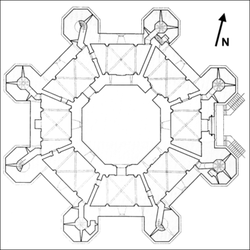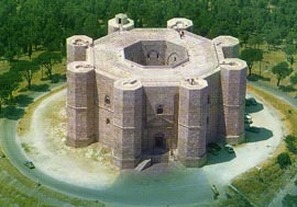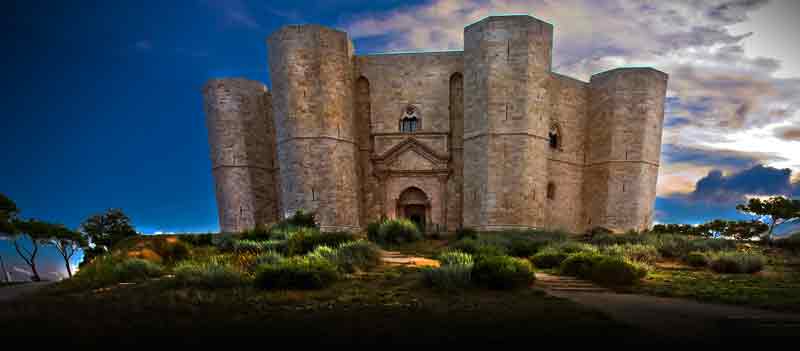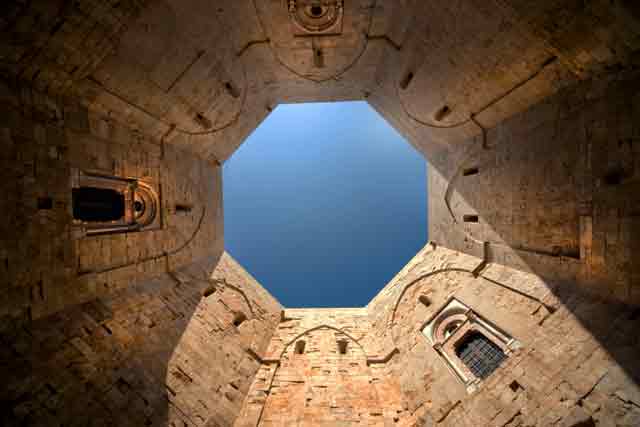 Plan of the Castel del Monte Plan of the Castel del Monte About 1500 feet above the sea on the Pugliese Murgia plateau stands a mysterious castle keep... the Castel del Monte (Castle of the Mountain). Around 1240, the Holy Roman Emperor Frederick II ordered its construction as a supposed hunting lodge, but there is no evidence that the Emperor ever used it and it seems the castle was never really completed. Oddly, it contains no normal features like other defensive castles of the period--no wall, no drawbridge, no moat, no stables. When built the area was lush with both flora and fauna, unlike the rather dry surroundings of today. Even historians are confused about the intended use of this fortress. By the 1700s, the castle originally had marble columns and walls but the marble and its furnishings were removed. Archaeologists tell us that it was constructed on the site of a much earlier fortress. At one time Castel del Monte was used as a prison and then as a refuge during a plague until it fell into a sad state of deferred maintenance. Although many thought it was to be used as the Emperor's "hunting lodge", scholars now believe it originally had a curtain wall and did serve as a citadel. In fact, because it is built on the highest point of the local terrain, a defending force would be able to see 360 degrees in all directions and even to the coastline 15 miles away. This fact along would suggest that in fact it was built as a military fortress, but there is no evidence of it ever being used as such. Frederick was responsible for the construction of many castles in Puglia, but Castel del Monte's geometric design was unique. The fortress is octagonal with 8 octagon towers at the corners. Originally, the towers were taller than they currently are. Each of the main rooms have vaulted ceilings and there are three towers with staircases. Castel del Monte also has an advanced plumbing system, which used rain water for the toilets and bathrooms of the fortress.  Eight seems to be a special number in its design--there are also eight rooms and an eight-sided courtyard in the center. There is much written about the possible symbolism of the octagonal design. The number 8 has secular, religious and mythological meaning; for example, the figure 8--or "lazy eight" (since it is rotated 90 degrees into a "prone" position) is used in mathematics to represent infinity; there are eight compass points; and eight is the union of divine infinity and human finiteness. The area surrounding Castel del Monte has a DOC designation for producing red, white and rose wines with vineyards and wineries on the slopes of the surrounding area. In Europe, most people are very familiar with Castel del Monte, as they keep a picture of it in their wallets--the fortress is depicted on the reverse of the Italian 1 Euro cent coin. In 1996 UNESCO gave the the fortress a World Heritage Site designation recognizing its unique architecture and cultural importance. Visiting: Castel del Monte is about 30 miles due west of Bari and about 15 miles from the sea. March 1 to September 30 from 10:15 to 19:45 October 1 to February 28 from 9:00 to 18:45 (The ticket office closes 1 hour before closing) Tickets: Regular fee 5.00 euros, reduced fee €2.50 (18 to 25 years). Free for children under 18 and over 65 years. --Jerry Finzi If you liked this post, please share it with your friends... ciao!
2 Comments
Toni McKeen
6/7/2021 07:40:49 am
Great description of the site. Now can't wait to visit it on my next trip to Italy.
Reply
Al Jaeger
4/11/2023 12:20:29 am
Thank you! Very concise. Could you kindly tell me when would be the best season to visit Castel del Monte?
Reply
Your comment will be posted after it is approved.
Leave a Reply. |
Categories
All
Archive
June 2024
|




 RSS Feed
RSS Feed
